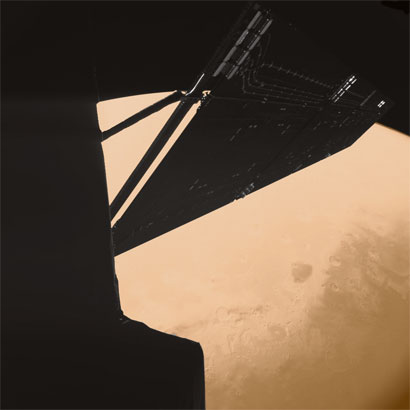The Green Planet

This portrait of the planet Mars is the finest yet made of the Red Planet and will be an iconic image of human Mars exploration in these early decades of the 21st Century. It was taken at the end of February by Europe's Rosetta spacecraft as it swept towards Mars for a very close flyby before continuing on its way to rendezvous with a comet in 2014.
 The smaller image represents a special moment in the history of Irish space exploration, because this dramatic view of the Martian surface – as an astronaut might see it, looking out across Rosetta's solar panels – was transmitted to Earth via an electronic switching device supplied by Space Technology Ireland in Maynooth. It is the first time that the success or failure of an international space mission has been dependent upon Irish technology and the image is important confirmation that the Irish communications package is working properly.
The smaller image represents a special moment in the history of Irish space exploration, because this dramatic view of the Martian surface – as an astronaut might see it, looking out across Rosetta's solar panels – was transmitted to Earth via an electronic switching device supplied by Space Technology Ireland in Maynooth. It is the first time that the success or failure of an international space mission has been dependent upon Irish technology and the image is important confirmation that the Irish communications package is working properly.
Space Technology Ireland was founded by Dr Susan McKenna-Lawlor, an Emeritus Professor at NUI Maynooth, who has flown experiments to Mars aboard European and Russian missions since the 1980s.
Meanwhile, in Houston, Texas, this month, a new generation of Irish Mars explorers was presenting research to colleagues gathered for the annual meeting of the world's top experts in planetary exploration. The young Irish scientists are involved in a broad range of Martian investigations: from the slopes of the titanic Olympus Mons, the largest volcano in the Solar System, to the shifting red sands of vast Martian dune fields, to the effects of global warming on Mars. The raw material they use is the stunning imagery of the surface that is being beamed back daily by European and American spacecraft, some of which has featured in these pages.
Of the four youngest researchers (all PhDs), not a single one is based at an Irish institution. There is growing concern within Ireland's small community of professional astronomers that urgent steps need to be taken to prevent a “brain drain” of the brightest and the best. Astrophysics courses are now being offered at universities across the country because they provide an exciting introduction to many of the key concepts in modern physics. However, senior figures in the physics community have become concerned that the nation's strategic focus on the areas of information and communications technology (ICT) and biotechnology is not leaving enough room for nurturing bright young scientists who are excited by other areas of research.
For several years now, FÁS has been offering internship and work experience programmes for postgraduates and apprentices, under the Science Challenge initiative. In addition, Enterprise Ireland and others have been supporting postgraduate students who might wish to pursue careers in Europe's space programme through courses at the International Space University (ISU) in Strasbourg. There are still several vacancies for Irish graduates at ISU this year, but the closing date for applications is imminent: http://www.isunet.edu/
